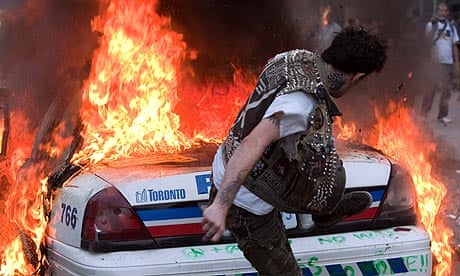Almost 500 people have been arrested after a group of anarchists torched police cars and smashed storefronts close to the G20 summit in Toronto.
The Toronto Star, citing security officials, reported that 480 people were detained after violence broke out when several hundred masked protesters broke away from a larger, peaceful demonstration yesterday.
Clean-up crews worked through the early hours to clear away debris. By sunrise, the Star reported, Queen Street West, in central Toronto, had been cleaned up except for scorched areas where police cars had been set on fire. A few shops had windows boarded up.
Some activists complained of police intimidation as they gathered outside cells where protesters were detained. About 30 were boxed in by officers and arrested, even though they had not been violent.
Bill Blair, the city's chief of police, admitted that officers had struggled to control the crowds, which at times numbered several thousand, yesterday.
The violence was carried out by a roving band, wearing black balaclavas, who shattered shop windows and rampaged through the centre of the city.
Protesters set fire to at least three police cars in different parts of the city, including one in the heart of the financial district.
One protester jumped onto the roof of a car before dropping a Molotov cocktail through the smashed windscreen.
Banks, coffee shops and small stores were targets, and protesters looted at least one retailer, storming out with clothing and the arms and legs of mannequins.
"A relatively small group of people ... came clearly with the intent of damaging property and perpetrating violence," the city mayor, David Miller, told a news conference. "They're criminals that came to Toronto deliberately to break the law."
Police used shields, clubs, tear gas and pepper spray to push back the protesters, who tried to head towards the security fence surrounding the summit site.
As the protests escalated, a Reuters reporter said police charged the crowds to seize individuals, and officers on horseback herded the group through the park where the protest had begun six hours earlier.
The reporter said police fired oversized plastic bullets in an effort to clear the park, although Blair said he was not aware that plastic bullets had been used.
Among those arrested was Jesse Rosenfeld, 26, a Canadian journalist who has written for the Guardian's Comment is free site. Witnesses said he was punched by police.
The violence broke out blocks away from where Barack Obama and other world leaders were meeting and staying.
"These images are truly shocking to Canadians," Canada's public safety minister, Vic Toews, said in a statement. "We are taking all measures necessary to ensure Canadians, delegates, media and international visitors remain safe."
The initially peaceful march was organised by unions and activists who say G20 economic policies favour the rich.
Anti-G20 groups have been demonstrating in Toronto in the build-up to the summit of rich and emerging economies, which follows a smaller meeting of the G8 economies in the Ontario resort town of Huntsville.
Canada has budgeted more than C$1bn (£644m) for security for the two summits, leading to accusations from activists that Toronto had been turned into a fortress.
Security is being provided by an estimated 19,000 police officers drawn from across Canada. Police closed a stretch of Toronto's subway system along the protest route, and the largest shopping mall closed after the protest began to turn violent.
"Free speech is a principle of our democracy, but the thugs that prompted violence ... represent in no way shape or form the Canadian way of life," Dimitri Soudas, the chief spokesman for the prime minister, Stephen Harper, said.
Yesterday's protest march was the largest demonstration planned during the weekend summits. Its organisers had hoped to draw a crowd of 10,000, but only about half that number turned out on a rainy day.
Previous global summit protests have turned violent. In 1999, 50,000 protesters shut down World Trade Organisation sessions in Seattle.
During a G20 meeting in London in April last year, Ian Tomlison, a newspaper seller, died after being struck by a police officer.
